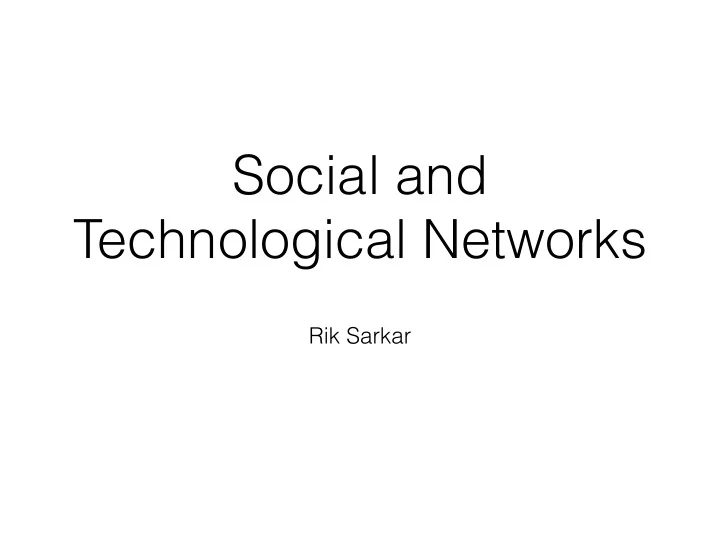

Social and Technological Networks Rik Sarkar
Social Networks • Network of friends • Node: Person • Edge: Friendship • Edge ab implies that a and b are friends � • E.g. Karate club network
Definition of networks • A network or graph G = (V, E) • V is a set of vertices • E is a set of edges • And edge e = (a,b), where a and b are vertices in V
Networks are informative • It is possible to learn or predict things by understanding the network
Social interactions
www
Computer networks: Internet
Roads and transport
Language
Chemistry/biology: Interaction between chemicals
Networks everywhere • To understand the systems we need to understand the networks
Community detection • In Karate club network • What are the groups of friends? • Who are likely to form alliances?
Spread of epidemics • Diseases spread in a network • A contagious disease spreads only between along edges of a network • Structure of the network determines how the disease spreads • Who is susceptible • Which community is susceptible
Epidemics • Spread of trends • New fashion, phone, gadget, idea … • Word of mouth is more valuable than general advertisement • People trust friends’ opinion more than ads • Endorsement by multiple friends more effective than one • Network structure affects epidemics • Certain people are more important than others • Targeting products/services intelligently can be critical to adoption
Social structures, communities, epidemics • Network analysis is not a fully solved problem • We are still trying to understand: • Detecting communities • Predicting spread of epidemics • Predicting who will become friends with who • Various reasons: • Sometimes the problem is difficult to define precisely (e.g. what are communities? ) • Sometimes we are missing information (who will meet who and become friends) • Some solutions are just hard to compute
Other networks • World wide web: • Nodes: pages (or sites); Edges : Links • Road networks: • Nodes: Crossings; Edges: Road segments
Other networks • Internet/Computer networks • Nodes: Routers/computers; Edges: Network connections (cables, wireless connections) • Internet has a densely connected core • It has redundancy: hard to bring it down by attacking a few nodes � • Image from “How robust is the Internet?”, Nature, 2000
Other networks • Bipartite networks • Users and products (e.g. Amazon, Netflix..) • Members and clubs • …
Other networks • Networks of communities/groups • Nodes: Groups of elements (e.g. people) • Edges: Between groups with common memmbers
Other network • Language • How does language change and spread in a network? • Suppose we represent words in a network • Nodes: Words • Edges: Connect similar words • What can we say about languages?
Network questions • How does network structure affect events? • Epidemics, formation of friendships, communities… • Which are the important/influential nodes in a network? • Most effect on others • Most effect on flow of information • Most effective in starting an epidemic • Most effective in stopping an epidemic • What are the communities? • Which quantities can help us to understand what to expect in a network? • How can we compute them efficiently? • How can we efficiently compute important nodes, communities, predict future edges, predict spread of disease etc?
Techniques • Algorithms, data structures • Clustering (e.g. community detection) • Dimension reduction • Optimization (e.g. influential nodes) • Linear algebra • Comparison with Random graphs
Tools • Model Analysis • Programming (data analysis) • Python or Java or C++ • IPython notebook • Gephi: Graph drawing tool • Netlogo: Simulation of networked agents
Course Information • 14:10; Tuesdays (LT4), Fridays (LT2) • 60% Written exam • Lecture notes, book chapters, parts of papers given in class • Exercise problems (not graded) given in class • Samples solutions (for some problems) given few days later • 40% Coursework
Coursework • 1 Project • Given in week 4. • Due Nov 25 (Week 10). • The project description will contain a general description of the problem. But no details of exactly how to do it. • Your responsibility is to: • Compose a precise problem statement • Make sure that the dataset available allows solution to the problem you state • Find a solution. May contain one or more of the following steps • Analyze network data and find interesting results (python or java or C++) • Design an algorithm and apply to network data • Theoretically analyze a model • etc…
Coursework • More details will be available soon • Main objective of project: � • Play with network data and ideas. Do something new! � • Find your own view on an aspect of networks
The course Is not about: � • Facebook (or whatsapp, or Linkedin…) • Making apps
The course Is about: � • Understanding mathematical techniques related to networks • Measures that distinguish structure and behaviors of networks • Efficient algorithms to compute these • Models that represent the most important properties of networks • Recent work and new ideas • Network science is a new subject, not everything is understood • Therefore now is the time to learn it (before it gets old)
Pre-requisites • Probability, set theory • Basic graph theory & Algorithms: Graphs, tress, DFS, BFS, spanning trees, minimum spanning trees, sorting • Linear algebra.
Linear algebra • Matrix operations • Graphs as matrices • Eigen vectors and eigen values
Recommend
More recommend